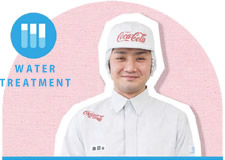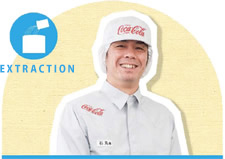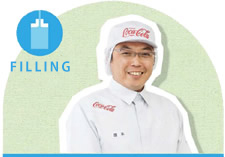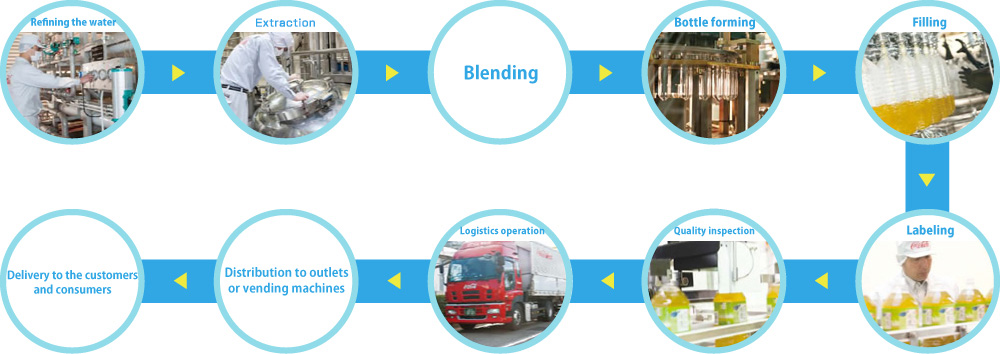Activities of the manufacturing team

From water treatment to bottle forming, filling ...CCBJI group ensures "quality" in all the stages of the manufacturing process.
To deliver tasteful products that are both safe and secure to all the customers and consumers without fail, CCBJI group focuses on maintaining high quality in every stage of the manufacturing process and completing the finished products with distinctive taste incomparable to any others.
Our manufacturing process begins from refining the water we use for our products. Let us explain our process using Ayataka as an example.

"Water" is what makes the big difference in the taste of our products.
We refine the water through multiple steps in the purification process.
The manufacturing process for "Ayataka" starts from "refining the water". At this stage which I am in charge of, the original water undergoes various treatments to be purified through specially designed filters. Since water is transparent, water quality cannot be determined just through visual inspection. It is important to conduct a detailed component analysis. Water quality is monitored 24 hours and the component analysis is conducted multiple times during the manufacturing process. In other words, the quality of water is rigorously managed through three eyes (two human eyes + one mechanical eye), which requires repeated fine tunings since it is easily and largely affected by the changes in the environment, including the daily weather.

By laying out the tea leaves evenly, we are able to produce the taste of green tea that resembles closely to the taste of tea poured right from the teapot.
Refined water is transported to the extractor, which is where the tea production begins. The main target of the "Ayataka" production team has been set to develop a product that features "the taste and turbidity very close to the authentic green tea poured right from the teapot". To achieve this target, a special tea extraction method has been adopted. Specifically, the essence of the tea leaves fed into a tank is extracted carefully in lukewarm water without stirring the leaves. A very challenging part of this method is the feeding of tea leaves. The leaves must be laid out evenly. If not, the amount of umami extracted from the leaves changes and affects the end taste. The carefully extracted tea essence is then transferred to a different tank.

When we manufacture PET bottles according to the standard specifications, we take great care in assuring both its safety and quality.
PET bottle is formed by blowing high-pressure air into a heated base material called the "preform" that looks like a test tube. If the amount of air pressure applied changes, the PET bottles formed will be inconsistent in terms of thickness, creating containers that become dented or get crushed more easily than others. To ensure a consistent output, the pressure setting is fixed for each type of PET bottle. Temperature is another factor that can largely affect the quality of PET bottle production. Especially sensitive to temperature are the molds used for preform blowing, which differ in the level of heat conductivity. Making fine adjustments according to the changes in the temperature is a very challenging task, and I am constantly looking for safer and more reliable ways of completing the PET bottle production by communicating closely with the members in charge of other steps in the manufacturing process.

The tea is filled in the bottles in an aseptic environment where bottles, tea and caps are all sterilized.
Filling is a process of putting the beverage (in this case, green tea) into the PET bottle. Like any other beverages, filling the PET bottle with green tea is conducted in an aseptic environment where the bottles, caps, and beverages are all sterilized beforehand. In the aseptic environment, which is an off-limit zone for human operators, filling is conducted thoroughly by machines. The role of human operators is to regularly confirm that the filling environment is kept in aseptic condition continuously, using a comprehensive checklist, in addition to monitoring the overall manufacturing process 24 hours and carrying out occasional sampling tests. Since filling is directly related to product safety, I believe that it is my responsibility to check the output of this process with my own eyes instead of just relying everything on the machines in the filler room.

In the final inspection stage, I believe it is very important to check our products from the perspective of the customers and consumers.
Once the PET bottles are filled with tea, the final process begins. My section inspects and verifies that labels are wrapped around the bottles properly, the best-by dates are printed correctly, the product fluid (tea in this case) is filled in the bottles appropriately, and so on. The position of labels and tightening of caps are first checked by machines, and then the ones that are rejected by the machines are further confirmed by human inspectors. Even a slightly misaligned label or different surface level of the tea may cause unexpected trouble to customers. I put great focus on this process because it is important to make the final checks from customers' point of view.

We observe each and every step in the manufacturing process with a sense of mission to allow no failure whatsoever.
Quality Control is responsible of checking each and every step in the manufacturing process. Even before the manufacturing begins, the fluid used for the product (tea syrup) and the container used to fill the product fluid are carefully tested to make sure that they are safe to use. During the manufacturing process, the bottle forming, for example, is conducted through a meticulous check system that measures the height, weight, capacity, strength and thickness of the bottle at a regular interval and sends the measurements to a computer where they are analyzed to confirm that they all meet the pre-defined safety criteria. As one of the members of Quality Control (QC), I am working every day believing that this team has a mission to deliver even better and higher-quality products to the customers and consumers. The QC team belongs to the Manufacturing Section. It is a reflection of the Company's policy to make the QC members fully acquainted with all the field plant operations involved in the manufacturing process. Knowing what is actually going in the production lines helps the QC members perceive their work with fresh eyes and find various discoveries on how they can further enhance the quality control operations. The integration of quality control and manufacturing team members allows the plant to establish new ways of delivering "safe and secure" products.

